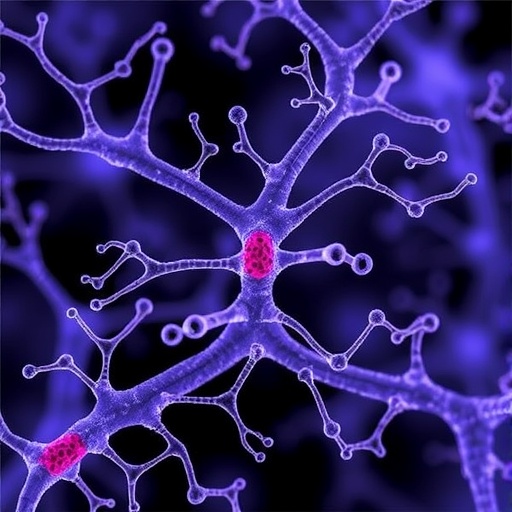Recent advances in biomedical research have unveiled the complex processes that underlie neural development, particularly focusing on how the embryonic precursor known as the neural tube organizes into various functional regions. Understanding this intricate process has enormous implications for both fundamental science and clinical applications, especially when considering diseases that affect neural development. Indeed, the human central nervous system emerges from the neural tube, fostering the formation of various structures essential for proper brain function. Interestingly, the isolation of specific mechanisms involved in this developmental patterning has proven essential for both developmental biology and regenerative medicine.
One pioneering approach to studying the neural tube’s formation involves the utilization of human pluripotent stem (hPS) cells. These cells offer remarkable potential due to their ability to differentiate into various cell types, including neurons, thereby making them invaluable for modeling human neurodevelopment. Recent investigations have highlighted the benefits of employing hPS cells as a robust alternative to traditional animal models, expanding our understanding of neural differentiation and related pathologies. The power of these stem cells lies not only in their versatility but also in their capacity to reflect human-specific developmental processes that are often not accurately replicated in lower organisms.
Within this dynamic research landscape, microfluidic technologies have emerged as game-changers, offering innovative ways to mimic biological processes on a microscale. A recent study has introduced a microfluidic gradient device that allows scientists to model the formation and regional patterning of the neural tube using hPS cells. This device is ingeniously designed to facilitate the precise placement of hPS cell colonies within microfluidic channels, thereby encouraging the development of intricate tissue structures that resemble natural neural formations. Such technological advancements open avenues for constructing not only neural tube-like structures but also forebrain-like tissues, contributing significantly to our understanding of embryonic neurodevelopment.
The microfluidic device allows for the controlled application of chemical gradients, simulating the extracellular matrix conditions essential for the regional patterning of the human neural tube. Specifically, this innovation fosters the establishment of rostral–caudal and dorsal–ventral gradients. By creating a conducive environment for hPS cells, researchers can influence their differentiation paths, leading to the development of either microfluidic neural tube-like structures (μNTLS) or microfluidic forebrain-like structures (μFBLS). This precise control over environmental variables essentially recapitulates the natural influences that guide embryonic development, permitting researchers to explore and characterize various developmental stages in detail.
The μNTLS not only demonstrates the capacity for forming lumenal structures, but it also reveals the spatial organization characteristic of early human neural development. This structure allows the investigation of essential markers of development, showcasing distinct regional identities among cells. Importantly, the emergence of secondary signaling centers within the μNTLS mirrors critical processes observed during natural neural development. Additionally, the formation of neural crest cells represents another crucial achievement, unfolding the complexities inherit within human embryogenesis and highlighting the distinct trajectories taken by various cell types during early neural development.
Moreover, the μFBLS adds another dimension by showcasing the compartmentalization of dorsal and ventral regions, akin to what occurs in developing forebrain structures. This spatial segregation allows researchers to observe how early neurons emerge and become layered in relation to their progenitor cells. Consequently, the μFBLS provides more than just an experimental model; it serves as a dynamic platform for studying the cellular transitions vital for the development of the human forebrain pallium and subpallium, two areas essential for higher-order cognitive functions.
One of the most captivating features of this microfluidic approach is the feasibility of long-term culture, enabling continuous observation of developmental trajectories. Coupled with live imaging techniques, researchers can visualize dynamic cellular events over extended periods, providing insights into the mechanisms driving neural differentiation. Furthermore, through immunofluorescence staining, scientists can mark specific cellular populations, facilitating a more detailed examination of temporal changes in cell behavior and gene expression. This multiplicity of techniques further enhances the utility of μNTLS and μFBLS for dissecting the intricacies of neurodevelopment.
In addition to traditional methods, the advent of single-cell sequencing technologies allows for a deeper understanding of the heterogeneity within these developing neural tissues. By analyzing gene expression profiles at the single-cell level, researchers can discern the diverse cellular states present within both the μNTLS and μFBLS. This granularity in data collection enhances our ability to construct detailed maps of neural differentiation pathways, shedding light on how various factors contribute to the emergence of distinct neuronal populations and regional identities.
Importantly, this microfluidic gradient device and its applications encapsulate a significant advancement in our ability to study human neurodevelopment. Researchers equipped with knowledge in polydimethylsiloxane soft lithography and cell culture techniques can implement this protocol effectively, which typically takes between eight to forty-one days to yield results. The timeframe largely depends on the specific neural structures being modeled and their developmental stages, further testament to the versatility and adaptability of this research approach.
As the scientific community continues to explore the depths of human neurobiology, the implications of such innovations resonate beyond basic research. Understanding neural tube formation and related regional patterning may lead to significant breakthroughs in developing therapies for neural tube defects and other congenital disorders that arise from disruptions in embryonic development. As this exciting domain of research unfolds, the capacity to model human neural development in a controlled environment paves the way for pioneering advancements in regenerative medicine, ultimately enriching our comprehension of neural diseases and facilitating the design of targeted treatment strategies.
In conclusion, the integration of microfluidic technologies with hPS cell models represents a transformative leap in neurodevelopmental research. The generation of spatially patterned neural structures offers unprecedented opportunities to uncover the biological principles governing neural formation and migration. As the scientific community delves deeper into these microfluidic systems, they hold the potential to redefine our understanding of human brain development, offering new insights that may one day translate into improved interventions for neurodevelopmental disorders.
Amidst the intricate ballet of molecular and cellular interactions that underpin the formation of the human nervous system, these developments offer a glimpse into the future of biomedical science—where computational modeling, advanced engineering, and cellular biology converge to illuminate the complexities of life itself, fostering a new era of understanding and therapeutic potential.
Subject of Research: Neural Development Modeling using Microfluidic Gradient Devices
Article Title: Generation of spatially patterned human neural tube-like structures using microfluidic gradient devices
Article References:
Xue, X., Rahman, O.M., Sun, S. et al. Generation of spatially patterned human neural tube-like structures using microfluidic gradient devices.
Nat Protoc (2025). https://doi.org/10.1038/s41596-025-01266-1
Image Credits: AI Generated
DOI: 10.1038/s41596-025-01266-1
Keywords: Neural tube formation, human pluripotent stem cells, microfluidic devices, neurodevelopment, cellular modeling, gradient exposures, lumenal structures, live imaging, immunofluorescence, single-cell sequencing.
Tags: animal model alternatives in researchcentral nervous system formationclinical implications of neural tube researchdevelopmental biology advancementsembryonic precursor cell researchhuman neural tube developmenthuman neurodevelopment studieshuman pluripotent stem cells applicationsmicrofluidics in biomedical researchneural differentiation modelingpatterns in neural developmentregenerative medicine techniques





